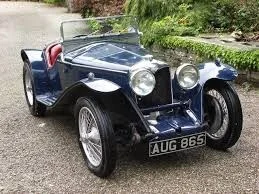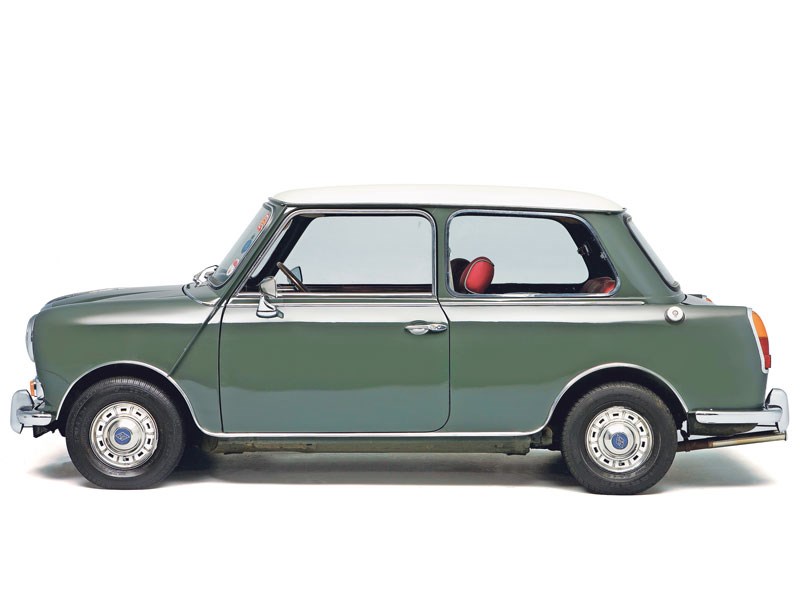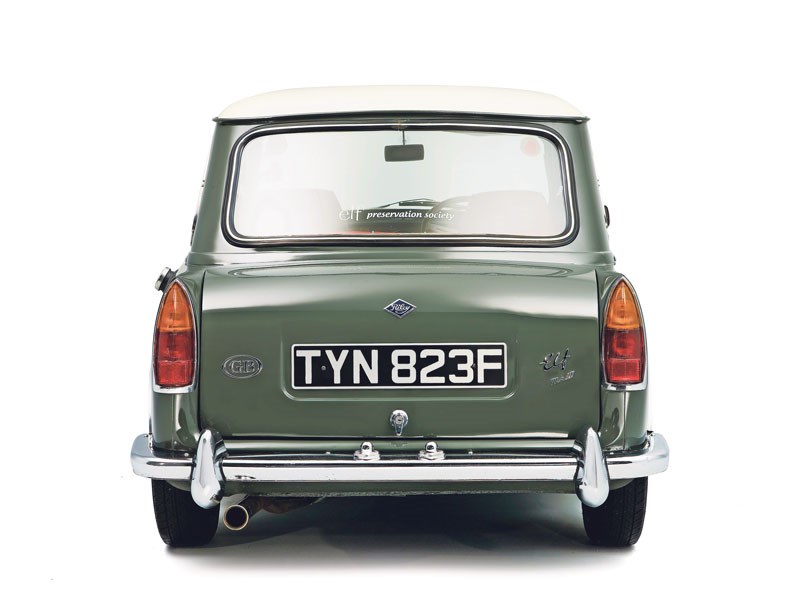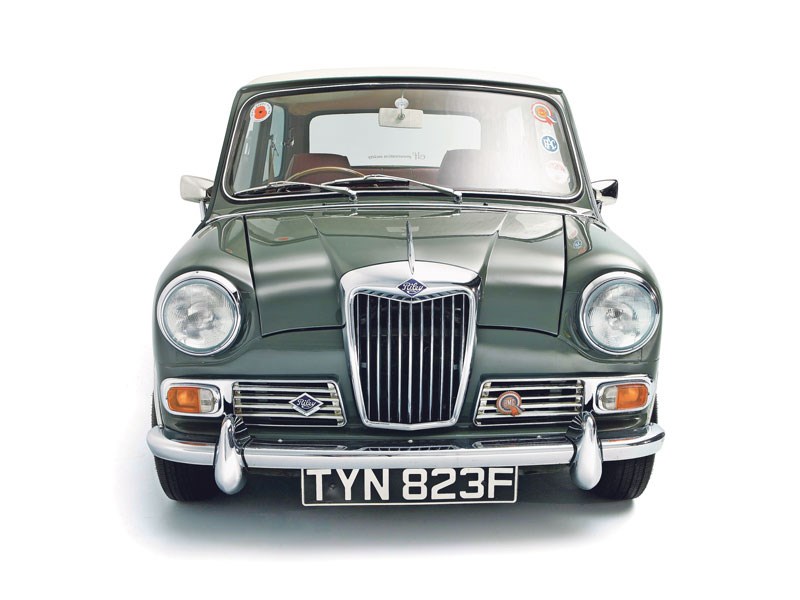Browse our range of expert Riley reviews and buyers guides. Get accurate information on features, values, and more.
RILEY 11/40 REVIEW
At the Olympia Show of 1919 Riley introduced an entirely new model, the Riley 11/40 10.8hp, developed to enable production to be more straightforward than before. By 1925 the highly successful 11/40 model was upgraded to 11.9hp with an enlarged engine of 1645cc by increasing the bore from 65.8mm to 69mm, retaining the same 110mm long stroke, thereby raising the sturdy detachable-head side-valve engines output from 35bhp at 3,200rpm to 42bhp at 3,600rpm. A bigger chassis and front wheel brakes were introduced from 1925. A wide iety of factory body styles were offered, often made by Midland Motor Body, another Riley family firm, and a number of cars were exported in chassis form, particularly to the Antipodes where demand proved strong.
RILEY BROOKLANDS REVIEW
The first Riley sports car to use the Nine engine was surprisingly not built by Riley, but the inspiration from the great J. Parry Thomas, soon to be tragically killed while attempting to break the Land Speed Record in "Babs" at Pendine Sands in March 1927. The project was picked up by Reid Railton, the first few 'Riley Brooklands Speed Models' being built by Thomson and Taylor. Driven by Railton, the new racing car won its first race at Brooklands in the Autumn meeting of 1927 at 91.37mph, astonishing for an 1100cc car. Many Brooklands Class G records were established in 1928, including the 500 miles at a respectable 87.09mph. Capable of 80mph in standard form, the 'Brooklands' in essence was created from a standard Nine chassis which was double cranked, shortened by fifteen inches, narrowed at the back, with underslung rear springs, in line with the frame. The bodywork was so low that when measured, the radiator cowl was only 36 inches from the ground, or 4 inches less than the roof height of a 1960s Le Mans Ford GT40! The prototype had a fabric body and was believed to weigh about 1,120 lbs, Coventry-built production versions arriving at 1,680 lbs with a road-equipped price of £395.
RILEY IMP REVIEW
Introduced in 1926, Percy Rileys 9hp, 1,087cc, twin-camshaft four was an outstanding engine design by any standards, ious versions powering Rileys until 1957. Clothed in stylish bodywork by Stanley Riley, the Coventry marques pre-war offerings were among the worlds finest small-capacity sporting cars. Right from the start it was obvious that the 9hp Riley engine possessed enormous potential as a competition unit, and at Brooklands J G Parry-Thomas and Reid Railton were the first to demonstrate just how good it was. The success of their racer led to a production version, the Speed Model, which soon became known as the Brooklands Nine. Six-cylinder Brooklands and MPH models followed, and from these Riley developed the next of its 9hp four-cylinder sports cars the Imp. Like the MPH, the Riley Imp featured a short-wheelbase chassis, of 7 ft 6 in in the latters case, that swept upwards over the front axle and was underslung at the rear, this layout having been first used on the Brooklands Six. The engine was mildly revised, twin SU carburettors fitted and a Scintilla magneto offered as an option. With its long bonnet, flowing wings and short tail, the Imp is without question one of the most attractive small sports cars of its' era. Made in limited numbers, it is a rarity today and much sought after.
RILEY ONE POINT FIVE REVIEW
Introduced in November 1957 at the London Motor Show, the Riley One-Point-Five was the result of a project conceived to replace the evergreen Morris Minor with a larger project. This project; codenamed DO1059, was intended to be capable of housing the larger B-series in 1200cc form. However, the Suez crisis ensured that axing the Minor would be commercial suicide; so with sales booming the replacement project was axed. The development work wasn’t wasted however, for the Riley One Point Five and less powerful Wolseley 1500 emerged as upmarket alternatives to the Minor and the 100E.
VITAL STATISTICS
Engine 1489cc, 4-cyl, OHV
Power 66bhp @ 5200rpm
Torque 77lb/ft@3500rpm
Top Speed 82mph
0-60mph 18.9seconds
Economy 27mpg
Gearbox 4 speed manual
WHAT TO LOOK FOR
BODYWORK
Rust is your main enemy and it can pretty much strike anywhere. Try to get underneath so you can check the vulnerable floorpan, but best advice is to look absolutely everywhere. Front wings are a known grot spot – along their tops, down their trailing edges and around the headlamps. The front panel and valance also corrode, as do the sills. If the sills get too bad, then the tinworm can spread to the floorpan as well. Moving back a bit more, the bottoms of the doors go frilly if the drain holes have become blocked, as do the rear wheelarches. And what the arches are attached to doesn’t fare much better, as the rear wings tend to disappear from the bottom upwards thanks to mud traps and thrown-up stuff from the road. Underneath, the front chassis legs, torsion bar and rear spring mountings go crusty. As issues with these are all MoT failure points, if a car has a valid certificate, they should be reasonably okay.
Much of the brightwork is Mazak, which tends to pit and corrode. Putting it right could mean spending lots of time searching around at autojumbles.
ENGINE
Thanks to B-series engines being shared with the MGA, parts are quite plentiful. The engines are robust, although they do tend to burn oil. If it is excessive – watch for clouds of blue smoke from the rear – then a rebuild will be necessary sooner rather than later. Check the oil pressure while on the move: it should be at least 50psi when warm and cruising nicely. Engines are usually a little noisy, thanks to worn timing chains, but it shouldn’t be excessive.
RUNNING GEAR
Synchromesh on the gearboxes is weak, especially with all the torque from the Riley, which causes second gear synchro to expire easily. On your test drive, change up and down the ‘box a lot to see how easy the shifts are. While whining from the transmission isn’t that much to be worried about, it will eventually lead to the gearbox needing to be replaced. However, the units could last for years making such slight protestations. On the MkIII cars – from 1961 onwards – the gearboxes were stronger, so these tend to last longer than the earlier ones. Back axles are resilient enough to outlast the rest of the car, unless they have been allowed to run dry.
The suspension borrows a lot from the Morris Minor, including the propensity for the front to collapse if the swivels aren’t lubricated every 1000 miles. Try to ascertain how conscientiously this has been done. Lack of attention will cause the joints to seize and, ultimately, to shear, leading to the front end giving way. Lever arm dampers go sloppy after 30,000 to 40,000 miles, and can also spring leaks.
Brakes are reasonable enough, although they are drums all around and without any servo-assistance.
INTERIOR
A leather and wood interior means it is vital to buy the best you can find, otherwise a retrim by a specialist may exceed the cost of the car. Controls and instruments are shared with a lot of other BMC cars, thus making them quite easy to source.
Electrics are simple enough, although the boot-mounted SU electric fuel pump does often play up due to poor contacts. Wiring looms go brittle with age too, which means that things stop working. Attempts to make a ‘quick fix’ quite often fail to correctly diagnose a more serious problem.
VERDICT
Rileys project a veneer of sporting luxury while being cheap to buy and run. They’re quite practical machines, with spacious boots and the ability to keep up with modern cars and cruise comfortably on motorways. And they’re sufficiently rare that a good one – or even a not-so-good one – will always turn heads. It’s still possible to use and appreciate one every day without ruining your appetite for 1950s and 60s small classics.
RILEY RMA REVIEW
The RM series was the last independently developed Riley before the company was swallowed up by BMC in 1952. We take a closer look at the RMA
If the elegant, flowing lines aren’t good enough reason to buy an RMA, then how about the superbly crafted wood and leather interior? Or the torsion bar front suspension and rack-and-pinion steering that ensures it is as good to drive as it is to look at? An RMA provides a worthwhile reason to raid your bank account, but check any potential purchase thoroughly to avoid having to re-mortgage your house too.
VITAL STATISTICS
Engine 1496cc/4-cyl/OHV
Power (bhp@rpm) 55bhp@4500rpm
Torque (lb ft@rpm) 78lb ft@2500rpm
Top speed 75mph
0-60mph 25sec
Consumption 26mpg
Gearbox 4-speed manual
WHAT TO LOOK FOR
BODYWORK & CHASSIS
The Riley’s bodywork provides the most scope for time-consuming and expensive repairs. As well as the chassis and bodywork, there’s an ash framework to worry about too. The earlier the car, the more likely it is to have suffered where it arches up above the rear axle. The body mounts are welded to the chassis and usually rust in isolation. Front wings rust adjacent to the beading where they attach to the body, and behind the headlamp nacelle where a metal plate is welded beneath the wing for the wing support bracket. Check the rear wing beading carefully too – any bubbling means there is severe rust beneath.
Sills consist of metal-skinned timber. Assess them by opening both doors and lifting them gently, while looking for movement in the pillar. Boot floors rust along the rear edge where the join a stiffener, and if the body mounts in the boot floor are weakened, the rear body can sag onto the bumper irons. Boot lids also bubble along the bottom edge, with the spare wheel compartment lid below often suffering as well.
ENGINE
The 1.5-litre engine should be good for 100,000 miles. You’re looking for oil pressure of 25-40psi at a hot idle, rising to an ideal 50psi at a steady 40mph. Very high pressures suggest part-blocked crankshaft oilways. If the bearings are worn, you may hear a knocking – but not a rumble – under acceleration. This can be addressed by converting to shell bearings. The first signs of piston rings and cylinder bore wear will be blue smoke from the breather on the inlet side of the engine. The piston stroke extends below the water jacketing, and they occasionally break piston rings. Gearboxes last well, but weak synchromesh and jumping out of third gear on the overrun are the first signs of excessive wear.
RUNNING GEAR
Steering play is usually caused by wear in the floating centre eye that travels up and down the rack. There is scope for adjustment, but if it fails completely, then rebuilding is a possibility. Rear leaf springs sag over time, so check that the car sits level and that the springs have retained their curvature. If the front of the car has a tendency to pitch, tired rear springs and dampers are likely culprits. Lower front wishbones can crack on early cars, but a webbing stiffener added later and progressively beefed up throughout production did away with this fault.
Brake cylinders can be rebuilt, but on hydro-mechanical systems it’s vital that the plunger is in good condition and that the linkages are set correctly. Poor braking may be down to a badly rebuilt system.
INTERIOR
Exterior fittings can generally endure rechroming. As well as rusting, radiator shells can suffer from starting handle damage when the guide tube cracks. Interiors last surprisingly well, and are usually saveable by the home restorer, providing the seats aren’t split or horrendously worn. Most are covered with a heavy-grained leather, so full professional retrims are subsequently expensive. Take this into account if a prospective purchase is in a poor state of repair inside.
OUR VERDICT
Despite the slightly daunting list of potential issues, don’t get the impression that the RMA is fragile or unreliable. Thanks to robust engineering and eminent driveability, bagging a good one will allow you to enjoy regular usage, perhaps even on a daily basis. Performance is leisurely, but the RMA is about so much more than that, so why not bask in the sumptuous leather and wood trim.
CLASSIC CAR REVIEWS - RILEY RME
Introduced in 1952, the Riley RME series were noted for their outstanding handling, torsion bar independent front suspension and rack and pinion steering giving 'a really comfortable level ride with a sureness of road holding which is quite outstanding'. An improved version of the RMA, the Riley RME included an open propshaft, hypoid axle, full hydraulic brakes, and bigger rear window. Streamlined sidelights, the deletion of running boards, and the introduction of rear wheel spats were features of the 1954 model year.
RILEY ELF & WOLSELEY HORNET REVIEW
These plush Mini siblings make superb classics, though the usual Mini pitfalls still apply
The usual Mini fun-factor is in full effect. That means super-direct steering, uncannily sharp direction changes and a steering wheel held at a rather unusual angle. Mk1s and 2s have the old ‘magic wand’ gearlever that seems to go up and down rather than back and forth. A remote lever was fitted from 1966 and offers greater accuracy and a shorter throw. Mk1s have less power. Mk2s have more urge and taller gearing, so are less raucous at motorway speeds. They’re not overly quick, but that’s fine, as you rarely need to slow down much for bends. The ride still has the fabled Mini bounce, even the ‘wet’ ones, but on smooth roads, there is still very little out there to touch one for cornering joy.
VITAL STATISTICS
Riley Elf MKII/III
Engine 998cc/4-cyl/OHV
Power (bhp@rpm) 38bhp@5250rpm
Torque (lb ft@rpm) 52lb ft@2700rpm
Top speed 78mph
0-60mph 24sec
Consumption 35-40mpg
WHAT TO LOOK FOR
BODYWORK & CHASSIS
Bodywork is by far the most important consideration. Much of the structure is standard Mini, which means rot can strike pretty much anywhere. Parts availability is generally good, but the front panel is unique to the Elf/Hornet and a replacement is £330. It is possible to modify one from a normal Mini – but only if you’re skilled. Look for corrosion sneaking into the seams between panels. Any rot you can see hints at much worse beneath the surface. As well as the seams, rot can strike around the headlamps.
Watch for corrosion around the scuttle and windscreen. The Elf was the first Mini to have winding windows, but later door skins fit OK. Make sure the mechanism works – handles for the Mk3 are brittle and hard to find. Check the sill and then check the footwells for dampness. If allowed, lift the carpet for a thorough check. The low height of the cars makes checking the underside difficult. You need to be wary though – restoring an Elf/Hornet’s body can easily result in thousands of pounds of expenditure due to the all-welded construction. Clamber into the rear and give the inner wheelarches a good shove, either side of the rear seat, too – another common rot spot.
ENGINE
Parts availability is such that most mechanical issues are easily overcome. The Mk1 had the 848cc unit, while the Mk2 and Mk3 had 998cc. Engines will get smoky with age and wear, but can soldier on for a good while before an overhaul is required. Rattly timing chains are annoying rather than dangerous. Radiators and the block can silt up, so check the state of the coolant and keep an eye on the temperature gauge. The gearbox is a weakness, living as it does in the sump of the engine. Watch for failing synchromesh (not fitted to first until mid-1968) and excessive noise suggesting a rebuild is required. Oil leaks are fairly standard, but be wary of anything excessive.
RUNNING GEAR
The rear wings are unique to these cars, and you can’t get new ones. Therefore, you need to check carefully for damage and any bodgery. There is an extension piece welded to the boot floor to extend it, so check carefully for rot in this area. Be aware that while the boot is larger, the hinges sink down into the load area and hamper useable space. You really need to get underneath to check the state of the rear subframe. The front tends to get protected by engine oil leaks but the rear can corrode readily. Budget on £800 if you pay a specialist to buy and fit one for you, possibly slightly more for a ‘wet’ car.
Chromework should all be in good condition, or present on a project car. Some of it is available new, but other bits will need hours of scouring autojumbles. Note that the exhaust is extended too, though bits are still plentiful.
BRAKES
All ‘Elfnets’ had all-drum brakes, but stopping power should still be pretty good. Discs can be fitted, but must be Cooper specification to allow use of the standard 10-inch wheels. Uprated drums are also available. The steering is typically Mini-direct and should be entirely free of play. From 1964, the cars were hydrolastic or ‘wet.’ Check the pipework for leaks. The ride should be slightly smoother than the ‘dry’ cars. Some may have been converted to ‘dry’ when problems have arisen. Watch for clicking CV joints on tight turns.
INTERIOR
Interiors are quite plush, and £1000 can easily be absorbed during a retrim. Seat facings are leather, though backs and sides are usually vinyl. Check the wood dashboard for cracks and delamination.
OUR VERDICT
The Elf and Hornet are easily forgotten in a sea of Minis, but they deserve recognition. They’re just as much fun to drive, but have an exclusive feel, with their cute bustles offering a bit more boot space – never a bad thing with a Mini. Inside, they lack the starkness of early Minis and are very pleasantly appointed.
RILEY RM REVIEW
Pre-war looks married to post-war road manners. Here's how to buy a peach of a Riley RM, not a lemon.
It may look old school with those running boards and exposed wings, but the Riley RM was Britain's first new post-war car that wasn't just a rehashed Thirties design. As a result, these stylish saloons are surprisingly modern to drive, with their twin-cam engines, torsion bar front suspension and rack-and-pinion steering.
WHAT TO LOOK FOR
Bodywork
Rotten steel and timber are common, so scrutinise the base of each A- and B-post closely, together with the rear window surround, sills and roof frame. All these are timber, and in the case of the roof it can be tricky working out what's going on as it's covered in vinyl cloth. Underneath is a perforated steel panel topped with wadding covered in hessian. This absorbs moisture, rotting the structure beneath and the vinyl cloth shrinks with age, aloowing water in and accelerating the deterioration. However, degradation of the cxar's structure and fixtures can look like shrinkage, so be sure to press on the various pillars as well as the main roof panel, feeling for any crumbling below.
The timber structure is clothed in steel panels, although some bonnet tops are aluminium and - periodically until 1953 - so were some bonnet side panels. All 2 1/2 litre cars got steel panels here while 1 1/2 models got aluminium or steel. Start by looking at the door bottoms and C-posts, then inspect the boot aperture and floor edges, along with the spare wheel compartment near edge.
Oily bits
Two different four-cylinder twin-cam engines were fitted to the RM, displacing either 1496cc or 2443cc. Cars with the smaller unit have a dark blue grille badge, 2 1/2 litre cars got a light blue badge. Checks for the usual wear-related rattles and knocks, while blue exhaustsmoke under acceleration points to oil being burned. The oil should be changed every 1500-3000 miles; keep an eye on the pressure gauge to see how healthy the engine is. Expect 40psi at 40mph on a 1 1/2 litre car, or 30psi on a 2 1/2 litre. Signifcantly lower readings suggest wear; much higher, and the oilways are clogged up or the relief valve is set incorrectly.
Check 2 1/2 litre cars for a blown head gasket and ensure it doesn't run hot once up to temperature - it could be a build up of sludge in the block. A high-gain radiator is not necessarily the answer due to the fan design, although many cars have one by now. If yours doesn't, budget on spending £150 to have the radiator re-cored. Also check the coolant-heated inlet manifold on a 2 1/2litre engine, whcih is prone to a leaking frost-damaged water jacket, whether the system is drained or not, leading to leaks. The four-speed manual gearbox is strong but a discernible rumbling signifies a worn layshaft. Also listen out for grumbling bearings, while a loud whine suggests tired gears. All cars feature a floor-mounted gear change, apart from early Roadsters (RMC), which have a column change. These contain a mass of linkages - wear here creates a vague gear change. Rebushing everything is likely to work wonders and it's aeasy to do although you'll need to have everything made in a machine shop first. Adjustment of the clutch rod mechanism can be fiddly, which is why clutch drag is so common, so check for slipping and judder as you pull away. This is common on the 2 1/2 litre cars, signifying tired engine mountings or inappropriate steady cable rubber, but replacements are cheap and easy to fit. Oil leaks from RMA and RMB rear axles are not uncommon, ao make sure there isn't lubricant all over the car's underside. Pulling to one side under braking can signify oil contamination to the rear brakes.
The steering rack is durable, but a new rack from the club (£174 without the pinion) should cure any excess play. The suspension lasts well if maintained properly, but there are eight greasing points including the track rod ends (plus one on post-1952 models' steering housing) which are sometimes neglected. Check for play in thje kingpins by jacking the car up at the front, putting a heel bar under the tyre, then looking for excess movement sa the wheel is moved up and down. The rear leaf springs also sag with age, while the lever arm damper lower links on pre-1951 2 1/2 litre cars can become disconnected, although repair is straightforward. Telescopic dampers were used from late 1951 and rarely give trouble. Rileys used a hydromechanical braking system until the introduction of the RME and RMF in 1952, at which point it was replaced by a fully hydraulic setup. Both systems use drums all round and while the earlier system is well up to the job, the later setup is even better. Both systems are reliable, so just make the usual checks for leaks, wear and poor adjustment.
Trim and electrics
Look for stitching that's falling apart, tears in the leather and delaminating wood. A professional retrim is very costly. The club recommends kits from Woolies to revive a tired interior on a DIY basis.
There's a fair bit of exterior brightwork, but the only real problems here involv pitting and missing items. A fair bit of trim is still available used, however, and doesn't cost the earth.
OUR VERDICT
Easy to maintain yourself on a DIY basis and capable of a useful turn of speed, the RM is also affordable and widely available, as well as enjoying a level of parts availability that's little short of astonishing. If you want pre-war elegance with post-war practicality, you've found the perfect car.




















